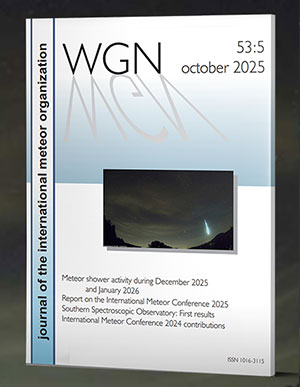Meteor activity kicks into high gear in August as
seen from the northern hemisphere. The main reason for all this activity is the
Perseid shower that peaks on August 12. The shower is active most of the month
and remains above the level of the sporadic background for a week centered on
August 12. The sporadic activity is also increasing as seen from the northern
hemisphere and is now nearly double the rates from just three months ago. As seen
from south of the equator, meteor rates are still decent but falling rapidly. The
sporadic rates seen at the beginning of the month will be twice as much as those
seen during the last days of the month. The Perseid radiant does not rise high
into the sky as seen in the southern hemisphere so rates from this shower are
greatly reduced when compared to the northern hemisphere.
During this period the moon waxes from just past
first quarter on the 9th to a nearly full moon on the 15th. This week the
moon will be located in the evening sky as the sun sets and set during the morning
hours. The window of darkness between moon set and the start of morning twilight
starts near six hours and decreases to zero. Successful observations can be obtained
while the moon is up but much better results can be seen when the moon is low or
beneath the horizon. As seen from the mid-northern hemisphere
(45 N) the estimated total hourly rates during the evening observers would be near
two. For morning observers the estimated total hourly rates should be near thirty.
For those located in the mid-southern hemisphere (45 S) morning rates would
also be near twenty and evening rates near two. Locations between these two
extremes would see activity between the listed figures. These rates assume that you
are watching from rural areas away from all sources of light pollution. The actual
rates will also depend on factors such as personal light and motion perception, local
weather conditions, alertness and experience in watching meteor activity. Moonlight
reduces meteor activity during the evening hours this week.
The radiant positions and rates listed below are exact
for Saturday night/Sunday morning August 9/10. These positions do not change
greatly day to day so the listed coordinates may be used during this entire period.
Most star atlases (available at science stores and planetariums) will provide maps
with grid lines of the celestial coordinates so that you may find out exactly where
these positions are located in the sky. A planisphere or computer planetarium program
is also useful in showing the sky at any time of night on any date of the year.
Activity from each radiant is best seen when it is positioned highest in the sky,
either due north or south along the meridian, depending on your latitude. It must
be remembered that meteor activity is rarely seen at the radiant position. Rather
they shoot outwards from the radiant so it is best to center your field of view so
that the radiant lies at the edge and not the center. Viewing there will allow you to
easily trace the path of each meteor back to the radiant (if it is a shower member)
or in another direction if it is a sporadic. Meteor activity is not seen from radiants
that are located below the horizon. The positions below are listed in a west to east
manner in order of right ascension (celestial longitude). The positions listed first
are located further west therefore are accessible earlier in the night while those
listed further down the list rise later in the night.
The following showers are expected to be active this week:
The Kappa Cygnids (KCG) are active from a wide radiant located at 18:56
(284) +58. This position is located in southern Draco, five degrees
northwest of the fourth magnitude star Kappa Cygni. As seen from the northern
hemisphere, current rates would be
near one shower member per hour. With an entry velocity of 25 km/sec. most
of these meteors will appear to travel slower than average. The radiant is
best placed near 2300 Local Daylight Time (11pm LDT) when it lies nearly
overhead for much of the Northern Hemisphere. Due to its high northern
declination this activity is not well seen from the Southern Hemisphere.
Alpha Capricornid (CAP) activity is nearly over for 2008. A few leftover
shower members may still be see from a wide radiant located at 21:12 (318) -06.
This position lies in western Aquarius, four degrees west of the third magnitude
star Sadalsuud (Beta Aquarii). The radiant is best placed
near 0100 local daylight time (LDT), when it lies on the meridian and is highest
in the sky. Current rates would be less than one per hour no matter your location.
Don’t confuse these meteors
with the nearby antihelion meteors, which have a radiant just to the east. Both
radiants need to be in your field of view to properly sort these meteors. With an
entry velocity of 23 km/sec., most activity from this radiant would be slow, a bit
slower than the antihelions. This radiant is well seen except for far northern
latitudes where it remains twilight all night long and the radiant does not rise
as high into their sky.
The large Antihelion (ANT) radiant is now centered at 22:00 (330) -10.
This area of the sky lies on the Capricornus/Aquarius border, ten degrees south
of the third magnitude star Sadalmelik (Alpha Aquarii). Actually any meteor from eastern Capricornus
as well as western Aquarius, could be a candidate for this shower. This radiant
is best placed near 0200 LDT when it lies on the meridian and is highest in the
sky. Rates at this time should be near two for northern observers and three for
observers south of the equator. With an entry velocity of 30 km/sec., the average
Antihelion meteor would be of medium-slow speed.
The Delta Aquariids (SDA) are still active from a radiant at 23:16 (349)
-13. This position lies in southern Aquarius, five degrees east of the third magnitude
star Delta Aquarii. The radiant is best placed near 0300 LDT, when it lies highest
in the sky. Current rates would range from one to two shower members per hour,
depending on your latitude. With an entry velocity of 41 km/sec., most activity from
this radiant would be of average velocities. These meteors tend to be faint so the
darkest skies are necessary in order to see this shower well.
The Perseids (PER) peak on Tuesday morning August 12 with average hourly
rates expected near one per minute. This weekend viewers in the northern hemisphere
should see 10-20 Perseids per hour during the dark morning hours after the moon
has set. The current radiant position lies at 03:00 (045) +57, which is located
in extreme northwestern Perseus, four degrees north of the third magnitude star
Gamma Persei. The radiant is well placed for those in the
northern hemisphere during the last few hours before dawn. Due to the high northern
declination (celestial latitude) of the radiant, rates seen from the Southern
Hemisphere are very low when compared to those seen north of the equator. At 59
km/sec., Perseid meteors are swift, often exhibiting persistent trains. More
details on viewing the Perseid meteor shower are available at:
http://www.amsmeteors.org/showers.html#PER
As seen from the mid-northern hemisphere (45N) the Sporadic rates are
becoming more active. One would expect to see approximately twelve random meteors
during the last hour before dawn from rural observing sites and two per hour
during the evening hours. As seen from the mid-southern hemisphere (45S) morning
rates would be near ten per hour as seen from rural observing sites and two
per hour during the evening hours. Locations between these two extremes would see
activity between the listed figures. Moonlight reduces sporadic activity during
the evening hours this week.
The table below presents a summary of the expected activity this week. Rates and
positions are exact for Saturday night/Sunday morning but may be used all week.
| SHOWER | DATE OF MAXIMUM ACTIVITY | CELESTIAL POSITION | ENTRY VELOCITY | CULMINATION | HOURLY RATE | CLASS* | RA (RA in Deg.) DEC | Km/Sec | Local Daylight Time | North-South | Kappa Cygnids (KCG) | Aug 17 | 18:56(284) +58 | 25 | 23:00 | 1 – <1 | II | Alpha Capricornids (CAP) | Jul 30 | 21:12 (318) -06 | 23 | 01:00 | <1 - <1 | II | Antihelion (ANT) | – | 22:00 (330) -10 | 30 | 02:00 | 2 – 3 | II | Delta Aquariids (SDA) | July 27 | 23:16 (349) -13 | 41 | 03:00 | 1 – 2 | I | Perseid (PER) | August 12 | 03:00 (045) +57 | 59 | 06:00 | 15 – 5 | I |



 You saw something bright and fast? Like a huge shooting star? Report it: it may be a fireball.
You saw something bright and fast? Like a huge shooting star? Report it: it may be a fireball.  You counted meteors last night? Share your results with us!
You counted meteors last night? Share your results with us!  You took a photo of a meteor or fireball? You have a screenshot of your cam? Share it with us!
You took a photo of a meteor or fireball? You have a screenshot of your cam? Share it with us!  You caught a meteor or fireball on video? Share your video with us!
You caught a meteor or fireball on video? Share your video with us!